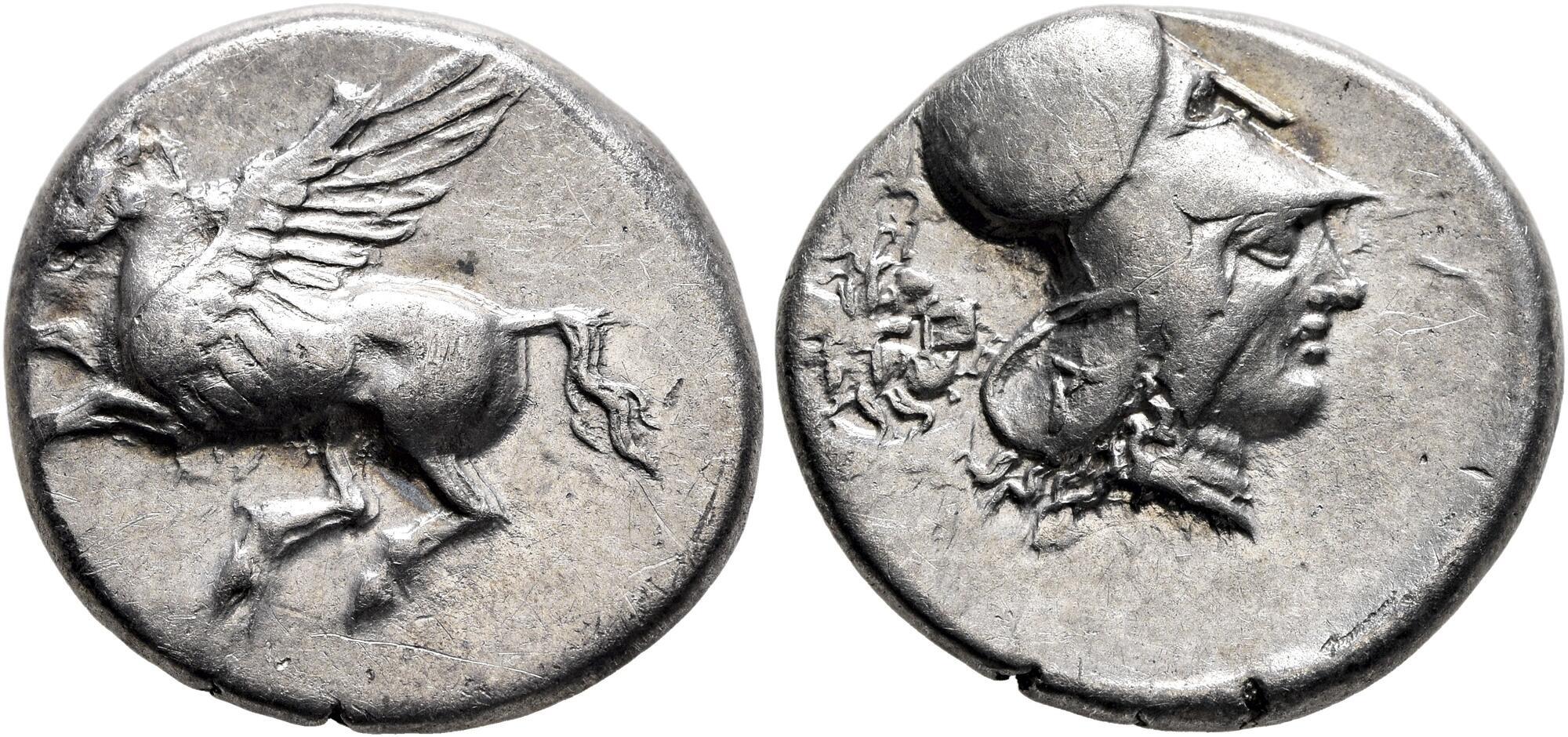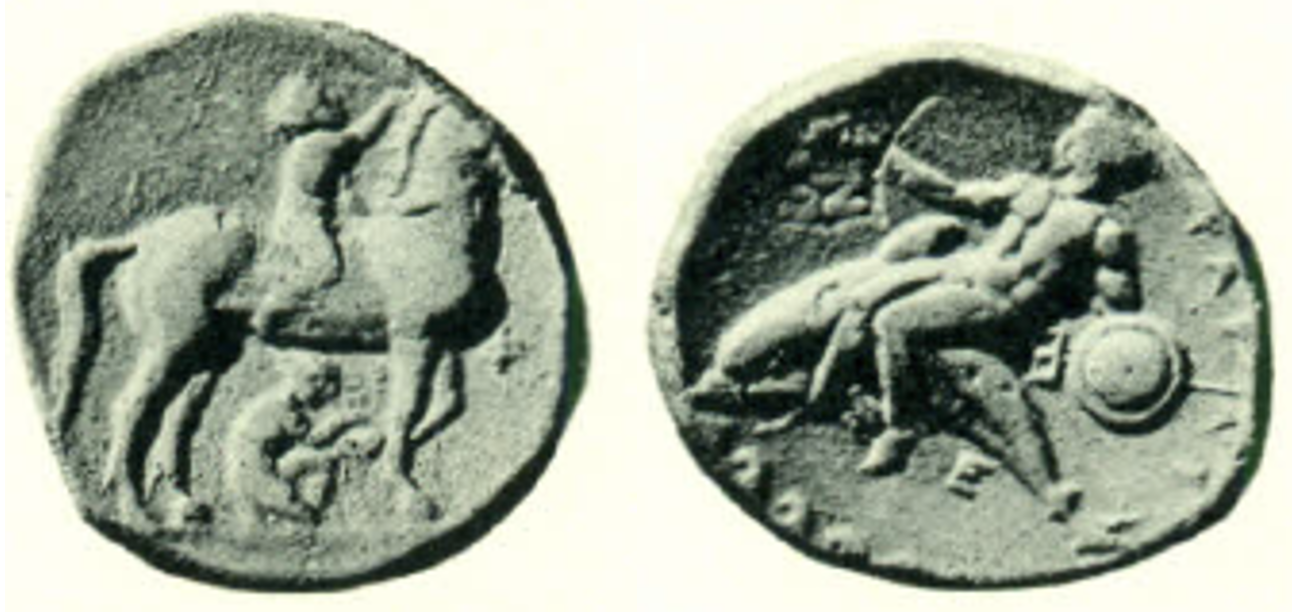1853 - Taras (nomos rider/Taras FB 50) over Ambracia (Pegasus/Athena) (Dewing coll. - Noe 1957, pl. XI, k): Difference between revisions
From SILVER
No edit summary |
m (Callatay moved page 1853 - Taras (nomos rider/Taras) over Ambracia (Pegasus/Athena) (Dewing coll. - Noe 1957, pl. XI, k) to 1853 - Taras (nomos rider/Taras FB 50) over Ambracia (Pegasus/Athena) (Dewing coll. - Noe 1957, pl. XI, k)) |
(No difference)
| |
Latest revision as of 08:55, 18 January 2024
343 BCE - 340BCE | TAPAΣ
Images
Overstruck variety

Ambracia Dewing.jpg [1]
Location/history
| Private collection(s)Private collection(s) ᵖ: | A. S. Dewing collection |
Overstriking coin
Description
| ObverseInscription or printing placed on the obverse.: | Youth seated on a horse right, crowning horse raisong foot for crouching youth to remove stone. In right field, φ. | ReverseInscription or printing placed on the reverse.: | TAPAΣ (Greek) Male character (Taras or Phalanthos), nude, seated on a dolphin to left, holding cantharos, trident and shield. Below, E and wave pattern. |
Mint and issuing power
| MintIdentifies the place of manufacture or issue of a numismatic object.: | Taras | Ancient regionAncient region. | Calabria | Modern countryModern country: Italy | AuthorityIdentifies the issuing power. The authority can be "pretended" when the name or the portrait of X is on the coin but he/she was not the issuing power. It can also be "uncertain" when there is no mention of X on the coin but he/she was the issuing power according to the historical sources: |
Chronology
| FromIdentifies the initial date in a range assigned in a numismatic context. 343 BCE toIdentifies the final date in a range assigned in a numismatic context.. 340BCE | Classical 480-323 BC |
Physical description
| MetalThe physical material (usually metal) from which an object is made.: Silver |
DenominationTerm indicating the value of a numismatic object. Examples: tetradrachm, chalkous, denarius.: nomos | ||
References
| Coin referenceReference of the Coin: | Noe 1957, group VII, p. 32, pl. XI, k | Coin series referenceReference to coin series study: | Noe 19571Noe 1957, group VII, p. 32, pl. XI, k, Fischer-Bossert 19992Fischer-Bossert 1999, group 50, n° 696 (V262/R543), HN Italy3HN Italy, n° 888, HGC 14HGC 1, n° 786 |
| Coin series web referenceCoin series web references: | |||
Overstruck type
Description
| ObverseInscription or printing placed on the obverse.: | Pegasus | ReverseInscription or printing placed on the reverse.: | Head of Athena right, wearing Corinthian helmet. |
Mint and issuing power
| MintIdentifies the place of manufacture or issue of a numismatic object. ᵖ: | Ambracia | Ancient regionAncient region. ᵖ | Epirus | Modern countryModern country: Greece | AuthorityIdentifies the authority in whose name (explicitly or implicitly) a numismatic object was issued. ᵖ: |
Chronology
| FromIdentifies the initial date in a range assigned in a numismatic context. 400 BCE toIdentifies the final date in a range assigned in a numismatic context.. 340 BCE | Classical 480-323 BC |
Physical description
| DenominationTerm indicating the value of a numismatic object. Examples: tetradrachm, chalkous, denarius. ᵖ: | stater |
References
| Coin type referenceReference to coin series study ᵖ: | Calciati 19905Calciati 1990, n° 56-85, HGC 3.16HGC 3.1, n° 206 | ||
| Coin series web reference overstruckCoin series web references overstruck: | |||
Additional data
| Frequency of overstrikesFrequency of overstrikes: | rare and concentrated | Level of confidenceLevel of confidence of the identification: | strong |
| RemarksRemarks: | |||
References
- ^ Noe, Sydney P. (1957), "Overstrikes in Magna Graecia", American Numismatic Society. Museum Notes 7, p. 13-42, pl. 5-14.
- ^ Fischer-Bossert, Wolfgang (1999), Chronologie der Didrachmenprägung von Tarent, 510-280 v. Chr., Berlin, De Gruyter, xvii, 495 p., [84] pl.
- ^ Rutter N. Keith et alii (eds.) (2001), Historia Numorum Italy, London, xvi, 223 p., 43 pl.
- ^ Hoover, Oliver D. (2018), The Handbook of Greek Coinage Series, Volume 1. Handbook of Coins of Italy and Magna Graecia, Sixth to First Centuries BC., Lancaster-London, 2018, lxi, 527 pages, 23 cm
- ^ Calciati, Romolo (1990), Pegasi, Mortara, Edizioni I.P..
- ^ Hoover, Oliver D. (2016), Handbook of coins of Macedon and its neighbors. 3. Part I: Macedon, Illyria, and Epeiros, sixth to first centuries BC, Lancaster, 437 p.
